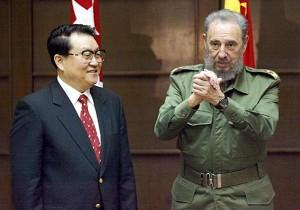Plans related to Beijing’s strategic underground city have been released, which indicate that the city is designed to occupy 20 million square meters, and is scheduled for completion in 2012. Once completed, the underground city will be the largest of its kind in the world.
In early August, China’s State Council and Central Military Commission announced that to strengthen the leadership and improve the scale and quality of underground construction, an oversight group for the construction of Beijing’s underground city was formally established.
The group, chaired by Wang Gang, director of General Office of the CCP Central Committee, along with two deputies, Wang Qishan (mayor of Beijing) and Zhu Qi (commander of Beijing Military Area Command), is led directly by the State Council and the Central Military Commission.
China’s highest ranking officials, including Hu Jintao, Wen Jiabao, Zeng Qinghong, Guo Boxiong, Cao Gangchuan and Xu Caihou, attended the inaugural meeting in the Building of the Central Military Commission.
Around the same time, Chinese authorities disclosed the existence of other underground cities and the roles they might play in case of a nuclear attack. According to a report released from the Research Office of the State Council, Shanghai, Nanjing, Hangzhou, Jinan, and other major cities were addressed.
It was revealed that each of these underground cities covers a total area of 200,000 to 300, 000 square meters on average and can accommodate 100,000 to 200,000 people. Later this year, these expansion projects will be activated.
The expansion and reconstruction projects, targeting 35 major cities, are expected to increase employment in the underground cities to 1.2 million people. Such a rise in employment is said to be capable of causing the GDP to rise from 2.5 to 2.8 percent.
At the inaugural meeting President Hu Jintao said that building Beijing’s underground city would be an an important strategic effort for national security and for the safety of future generations. It might also provide shelter for citizens in case of emergency or war.
Wang Gang added that compared with major cities of Europe and the United States, Beijing’s underground city actually lags 40 years behind. He claimed that in the case of a sudden large-scale disaster or war, shelters in Europe and the United States have the capacity to hold 80 to 90 percent of local citizens, while Beijing’s underground city can currently only provide safety for 8 to 10 percent of its people.
Wang Gang also disclosed that the underground city would be designed to occupy 20 million square meters and was scheduled to be completed in 2012. When completed, the city would then be the largest in the world. He pointed out the difficulties and troubles being faced during the construction, such as complex project data, lack of international experience, foundation subsiding, and security problems.
In the meeting, some engineering experts warned that maintaining such a large-scale underground construction in times of peace might take on a most serious aspect to Beijing, as it would be built in the political center of the country for military and civilian use on a large scale.
The future Beijing underground city will link up its 11 districts and 7 counties through 20 main lines of communication. Command centers will be located in the east, south, west and north sides of the city, with 12 to 16 sub-centers throughout. In times of peace, 52 exits will be available, while in times of war or emergencies, 128 to 168 sites will be opened for evacuating inhabitants and deploying materials.
The underground city will be linked to the CCP’s central compound, including government and military, military bases, airports, railways, strategic roads, parks and suburban strongholds.
Since March of this year, a construction corps composed of over 12,000 engineers has begun construction at 15 separate sites in Beijing.

